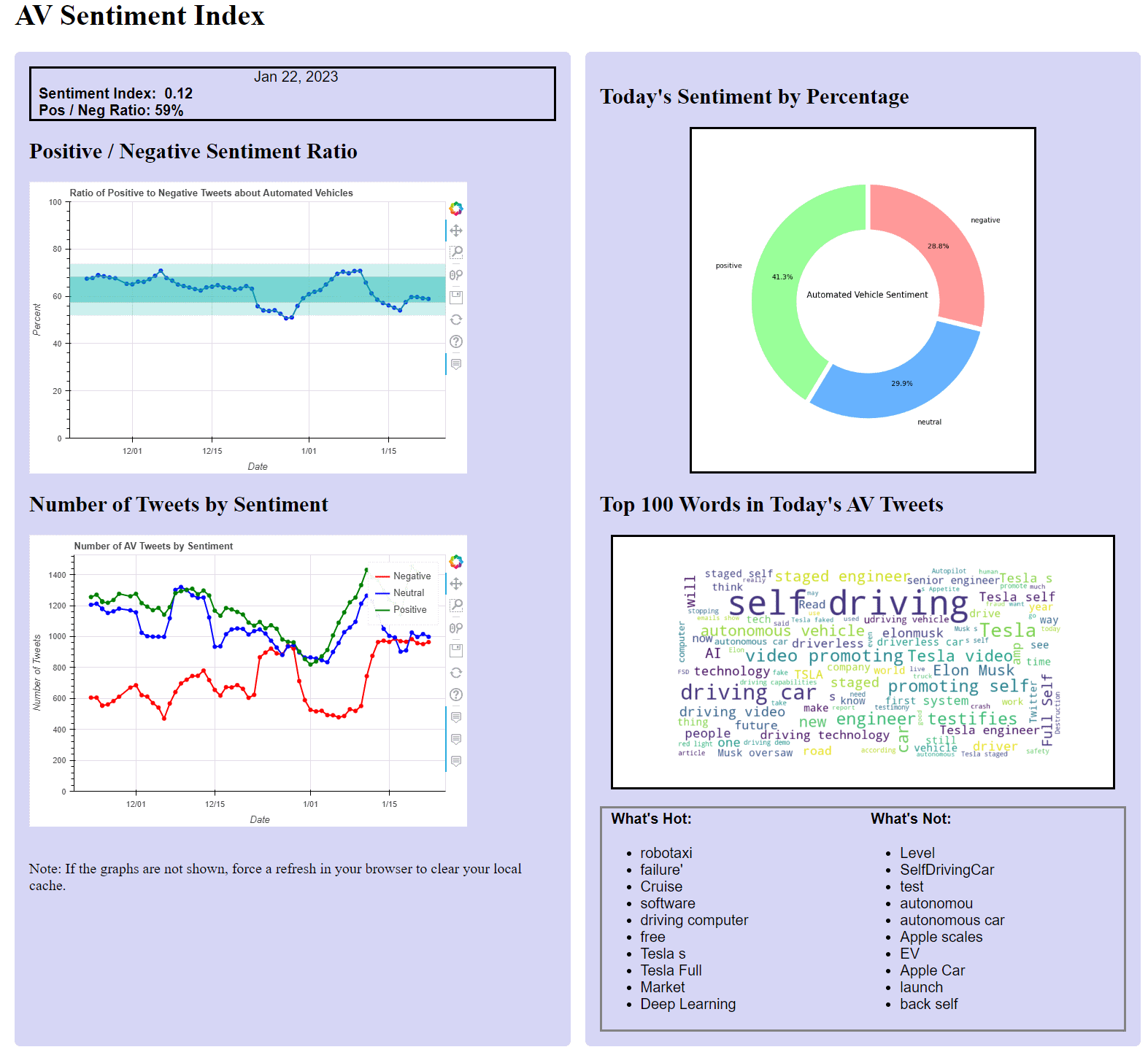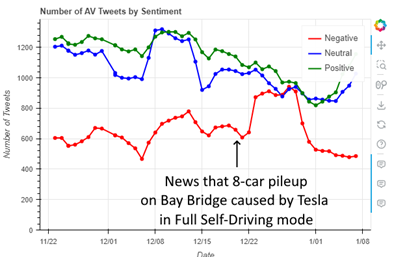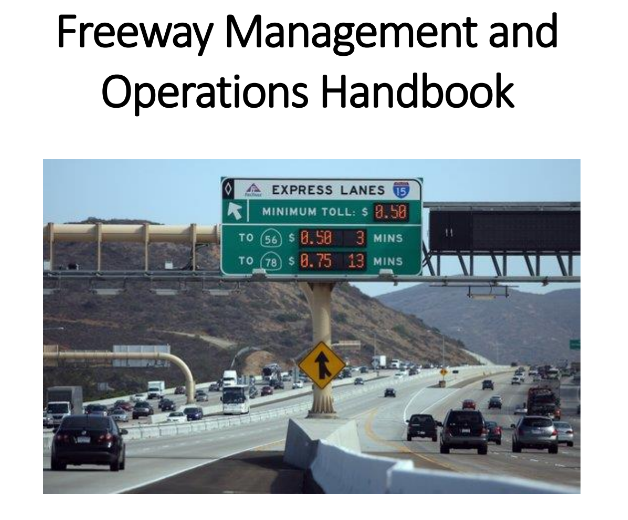

This has some material and links from my former work as an independent consultant that still may be of interest to some.
I have a side project that I ran to track daily sentiment on Twitter (now X) concerning automated and electric vehicles. I collected data and produced daily updates for about 15 months.I tracked the daily sentiment indices, the ratio of positive to negative sentiment tweets, the numbers of positive, neutral, and negative tweets each day, as well as a word cloud of the most popular 1 and 2 word combinations in the relevant tweets and how they differ from the previous week. The figure below is a sample of the daily indices that were tracked.

 I've
written two reports on the anlysis of the data. The first report,
Seasonality
and Variance of Twitter Sentiment Regarding Electric and Automated Vehicles
looks at the seasonality, variance, long term trends, and skew in the
sentiment data. The second report,
The
Best of Days, the Worst of Days: Twitter Sentiment Regarding Automated Vehicles,
looks at a dozen outlier days, the causes of the extreme sentiment on those
days, and the long term impact of these events.
I've
written two reports on the anlysis of the data. The first report,
Seasonality
and Variance of Twitter Sentiment Regarding Electric and Automated Vehicles
looks at the seasonality, variance, long term trends, and skew in the
sentiment data. The second report,
The
Best of Days, the Worst of Days: Twitter Sentiment Regarding Automated Vehicles,
looks at a dozen outlier days, the causes of the extreme sentiment on those
days, and the long term impact of these events.
Unfortunately, Twitter shut down their free API that allowed researchers to collect this type of data, and currently charges extremely high, unaffordable fees for such access. That is why the data collection ended after about 15 months. However, I have archived all of the data. Please reach out to contact me (first_name.last_name@google.com) if you would like more information or to discuss access to the data.

As the TRB Freeway Ops Committe states, “The Freeway
Management and Operations Handbook (FMOH) provides an overview of the
institutional and technical issues associated with the operation of a freeway
network. The FMOH provides an overview of the potential strategies, tools, and
technologies that may be used to support the management and operation or be
considered in the planning or design of a freeway network.
The FHWA sponsored the development of the first “Freeway Management Handbook” in 1983 and subsequent updates. This most recent version was sponsored by the FHWA, as well as the TRB Freeway Ops Committee.
This edition was completed in 2017 and is a complete rewrite of the previous handbook. It brought every chapter up to date while and adding new information on subjects such as connected and automated vehicles. Unfortunately, formal publishing by the FHWA has been indefintely delayed, but the complete final Freeway Management & Operations Handbook is available for free reading and/or download on the TRB Freeway Ops Committee website.
 This
paper provides a brief introduction to the concept of access to destinations and
then compares access to jobs for auto travelers versus transit riders for 49
metropolitan regions in the U.S. The analysis found that even for the the most
transit-friendly city (New York City), transit riders had access to only 8% of
the jobs that automobile drivers had for 30 minute trips, and the percentage was
still at just 19% when examining 60 minute trips. The modal accessibility gap
can and should be reduced, however the gap is so large that it is unrealistic to
expect it to be eliminated in any U.S. city. Transit can and should be made
more competitive, but reducing the gap to near zero would require putting large,
regulatory restrictions on auto use, which would likely have large negative
effects on the regional economy.
This
paper provides a brief introduction to the concept of access to destinations and
then compares access to jobs for auto travelers versus transit riders for 49
metropolitan regions in the U.S. The analysis found that even for the the most
transit-friendly city (New York City), transit riders had access to only 8% of
the jobs that automobile drivers had for 30 minute trips, and the percentage was
still at just 19% when examining 60 minute trips. The modal accessibility gap
can and should be reduced, however the gap is so large that it is unrealistic to
expect it to be eliminated in any U.S. city. Transit can and should be made
more competitive, but reducing the gap to near zero would require putting large,
regulatory restrictions on auto use, which would likely have large negative
effects on the regional economy.
The full paper can be found at A Brief Note on Modal Access Across America.
![]() “There’s
no future that doesn’t have ambient computing or voice activation… none.” (Mark Cuban)
“There’s
no future that doesn’t have ambient computing or voice activation… none.” (Mark Cuban)
This was an open source hobby project, rather than a
professional one, but it utilized my knowledge and interest in traveler
information and provided me with additional insight and experience for my
professional work. Open data and voice interfaces will both have growing roles
in transportation. As a consultant in the ITS field, I’ve always felt that there
was great value in understanding multiple perspectives, from a high level down
through implementation. With that in mind, I was looking for a personal project
to use one of the datasets that VDOT provides through their great SmarterRoads
open data portal, and I also wanted to develop a custom voice interface Alexa
Skill. The result was a certified and published Alexa skill: Sixty Six Tolls.
For those outside the Northern Virginia area, Interstate 66
inside the I-495 Beltway is a HOT road with dynamic tolling for portions of the
day. While the toll may change between checking the cost at home and the time a
driver reaches their entrance, it’s still useful to have an idea of the highly
variable toll, especially since tolls for the entire 10 mile length have
sometimes spiked at over $40. As Alexa is integrated into new cars, the skill
will be accessible by voice while en route.
Sixty Six Tolls provides the user with real-time tolling data
between any entrance and exit pair, allows the user to save their most frequent
inbound and outbound interchange pair, and also provides comparative speeds and
travel times on I-66 and US Route 50.
Check it out for yourself on your Alexa device (first
enable it with “Enable Sixty Six Tolls. From then on, just say “Open Sixty Six
Tolls." You can read more about how to use it here.
For technical details, including a link to the open sourced code, go to the
project write-up on hackster.io.